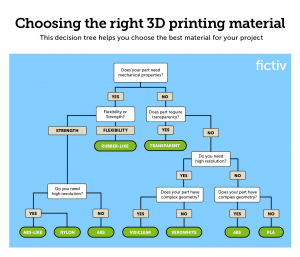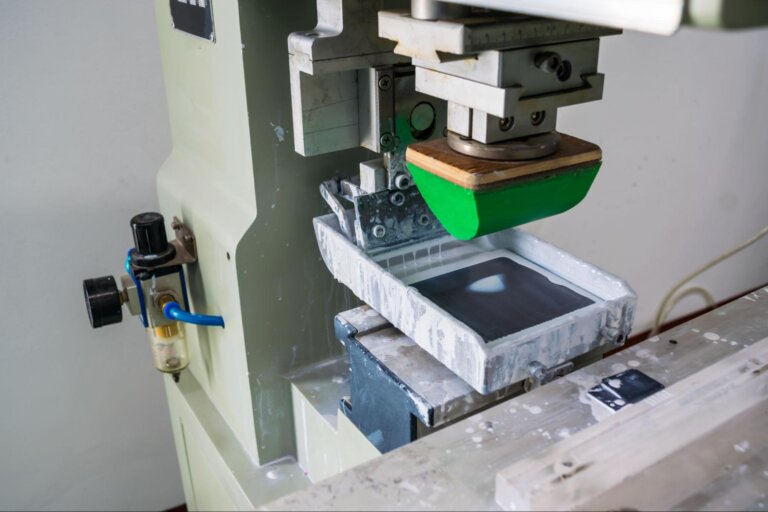Time to read: 3 min
This quick start guide is designed to you help you become familiar with Fictiv’s online tools for 3D printing.
Read on for a step-by-step guide to help you:
- Properly prepare your CAD files
- Export your files with the correct settings
- Upload your files to Fictiv
- Choose the right 3D printing material
Step 1: Prepare Your CAD Files
Before uploading your CAD files to Fictiv, it’s important to double check your files are properly prepared.
Here are 3 things to look out for when checking your files:
1. Only one part per file
Be sure to separate parts into individual files and delete any unnecessary shells.
2. Be aware of maximum print sizes
Here are the maximum print sizes for each material:
| PLA | 285 x 153 x 155mm | 11.2 x 6.0 x 6.1in |
| ABS | 406 x 355 x 406mm | 16.0 x 14.0 x 16.0in |
| VeroWhite | 290 x 190 x 140mm | 11.4 x 7.4 x 5.5in |
| Transparent | 290 x 190 x 140mm | 11.4 x 7.4 x 5.5in |
| Rubber-Like | 342 x 342 x 200mm | 13.4 x 13.4 x 7.8in |
| ABS-Like | 342 x 342 x 200mm | 13.4 x 13.4 x 7.8in |
| Nylon | 340 x 340 x 600mm | 13.3 x 13.3 x 23.6in |
| VisiClear | 295 x 180 x 200mm | 11.6 x 7.0 x 7.8in |
If your part exceeds the following dimensions, use this quick tutorial to slice your part.
3. Check your units
It’s very easy to accidentally export your model in the wrong units; double check your units before submitting your files so you receive the right size part!
Step 2. Export Your CAD Files
Best Choice: STEP File
STEP files carry all of the parametric data required so we can easily read the part size and geometry.
Second Choice: STL File
STL files work well, however there are no associated units and holes/gaps (watertightness) can cause issues when producing parts.
Here are the specific settings to choose when exporting STL files from Solidworks, Inventor, and Rhino:
Solidworks
- Click Options in ‘Save As’ menu
- Set Deviation to 0.0005in and the Angle to 5 degrees
Inventor
- Click Options in ‘Save As’ menu
- Set Detail Level to High
Rhino
- After saving filename, select Binary
- Mesh Options > Detail Controls
- Set Max Angle to 20 degrees
- Max Aspect Ratio to 6
- Minimum Edge Length to 0.0001
Step 3: Upload Your Files
Here’s a few things to look out for when uploading files to Fictiv.
Keep Files Under 10MB
We prefer files to be under 10MB; if your files are larger than this, refer back to step 2 to adjust your settings and lower your part resolution.
Select the Proper Units
When you submit files for a quote, you’ll select the part units; make sure they match the units you designed the model in.
Step 4: Choose the Right Material
Use this decision tree to help you choose the best material for your part:

If you choose Rubber-Like, make sure to select a durometer.
Here are some rubber comparisons for each shore choice:
| Shore 27A | Rubber Band |
| Shore 40A | Pencil Eraser |
| Shore 50A | Bike Inner-tube |
| Shore 60A | Tire Thread |
| Shore 70A | Shoe Heel |
| Shore 85A | Rollerblade Wheels |
| Shore 95A | Shopping Cart Wheels |
Note that each part can only be printed in one color.
All materials, with the exception of ABS and PLA, print in their natural color:
| ABS | Contact us for color availability (Matte Finish) |
| PLA | Contact us for color availability (Glossy Finish) |
| VeroWhite/VeroBlack | Off-white/Black |
| Transparent | Clear (ask us about clarity options) |
| Nylon | White |
| Rubber-Like | Black |
| ABS-Like | Off-white |
| VisiClear | Translucent |
Still have questions that weren’t covered in this guide? You can always reach out to an expert engineer on the Fictiv prototyping team here.










